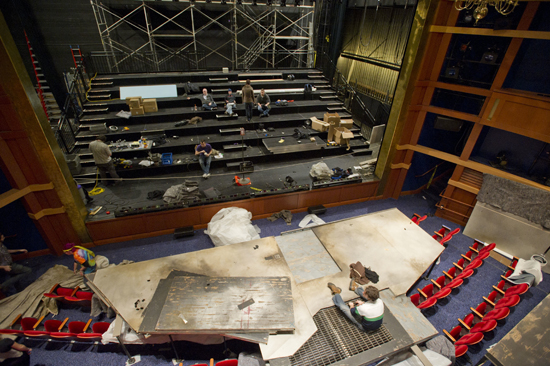Imagining an Urban Apocalypse
Marisol opens tonight in a theater remade to look, well, awful

In another life, Liz Schurra might have been a wrecking ball. She’s certainly enjoying her theater production class project: take the plush Virginia Wimberly Theatre and trash it.
Schurra (CFA’11), set designer for the College of Fine Arts student production of Marisol, which opens tonight, spent last week with her team cannibalizing the steel-and-wood walls from another set, disassembling what they could, and hacking apart the rest. When the audience files in for Marisol, it will see debris from that demolition littering the theater, which elsewhere will be draped in drab muslin, transforming this relatively new (2004) space of gorgeous red-upholstered chairs and gold proscenium to a landscape of blight. “If it looks absolutely terrible, it means it’s really good,” says Schurra.
One other change awaits show-goers: they’ll be watching the play from the stage, while the actors perform in the house section.
Flipping audience and performance spaces and disfiguring a lovely milieu are the unusual brushes with which Schurra and director Tara L. Matkosky (CFA’10) paint playwright Jose Rivera’s grim vision of a post-apocalyptic New York City. A fantasy about society’s all-too-real violence and social injustice, 1993 Obie winner Marisol centers on a cosmic revolt by angels against God that pulverizes New York into a war zone, where food and water are scarce and thugs attack the helpless. The play is meant to unsettle the audience, but as Matkosky and Schurra scoped out the Wimberly’s comfortable environment, the director says, “there was nothing frightening or disturbing about the experience.”

To discombobulate patrons, she and Schurra (above) decided to seat them on risers placed on the stage. The actors, meanwhile, will perform on a platform made from that disassembled set and erected on legs above roughly half of the house seats. The balcony and the scaffolding in front of and behind the audience will also feature in the play’s action.
Seating audiences on stage isn’t new (ironically, the Huntington Theater Company, in residence at Boston University, which manages the Wimberly, toyed with the idea for a 2008 production, ultimately discarding it, says production manager Todd Williams). But it did pose logistical challenges. It lowered the potential box office—only 120 patrons can squeeze onto the stage, versus 360 in the house—while raising blood pressures for the Wimberly’s management.
“We didn’t want the seats getting stepped on, jumped on, or otherwise damaged,” says Williams. “We also worked with the students to find safe places to hang backdrops, chandeliers, lights, and sound equipment in places that weren’t necessarily originally designed for those purposes. We wanted to make sure that the same fire safety rules that apply to materials used on stage were used for the scenery in the house.”
“The Wimberly is our baby,” he adds. “Many of the Huntington’s staff were involved in the design and construction.”
The result? “The students have been really great to work with,” according to Williams. “They took our concerns to heart and were very creative in coming up with solutions. They wanted to shake up expectations of what theater is for the audience from the moment they walk in the door, and they really have.”
The inside-out staging has been tricky for the actors. “No matter what floor plan was created during rehearsal, nothing could truly replicate the intricacy of the actual space,” says Cloteal Horne (CFA’12), who plays the title character’s guardian angel and spends much of the play on scaffolding in the mezzanine, about 13 feet off the ground. “However, the tech process has been extremely productive and exciting. The world is coming together, and we are understanding the functionality of it more and more.”
“The more time we spend with it, the more things like ladders from the 13-foot scaffold or splintered platforms feed the energy of the show,” says Chelsea Kurtz (CFA’11), the production’s Marisol. “We’re living in a world that has been totally destroyed.”
When Marisol premiered, New York seemed a crime-ridden, dangerous place. With the quality of life markedly improved there in the almost two decades since, have events left Rivera’s gloomy message dated? “Maybe things don’t appear as blatant,” replies Matkosky, who is returning to her alma mater from her day job at a Boston consulting firm to direct. But you can still see homeless people, she says, and the recession has sent poverty levels soaring.
And Marisol, she says, reminds us that “there’s a need for people in our society to rise above that.”
Marisol runs through December 17 (no performance December 13) at the Wimberly Theater at the Boston Center for the Arts Calderwood Pavilion, 527 Tremont St., Boston. Show times, ticket prices, and directions can be found here. Tickets can be purchased here.
Rich Barlow can be reached at barlowr@bu.edu.
Comments & Discussion
Boston University moderates comments to facilitate an informed, substantive, civil conversation. Abusive, profane, self-promotional, misleading, incoherent or off-topic comments will be rejected. Moderators are staffed during regular business hours (EST) and can only accept comments written in English. Statistics or facts must include a citation or a link to the citation.